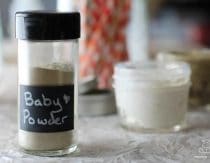
Did you know that the ACTUAL BIRTH EXPERIENCE can affect a child’s cravings . . . for life?
Sounds crazy, I know, but it’s true! The sacred, life-changing, point-your-bum-at-your-mother-in-law-and-push experience is more than we could possibly have imagined. Here’s why:
As far as science knows, babies digestive tracts are sterile while they’re happily bebopping in our tummies.¹ No bacteria. No viruses. No fungi. Nada.
Then labor begins. As babies descend into the birth canal they get their first “meal”: a dose of the microbes/micro-flora living in their mommies you-know, which believe it or not can affect food cravings for life. Okay, altogether now, let’s all shout a collective Ewwwww! There, I feel better. 🙂

Bugs We Love
So what are these micro-flora and why are they so important? Well, in a healthy mother you will see a lot of Lactobacillus species, namely Lactobacillus acidophilus, Lactobacillus casei and Lactobacillus fermentum (plus some bad guys, too in small numbers). These beneficial bacteria perform vital functions within our bodies, such as:
- Digesting and absorbing certain carbohydrates. Without good gut bacteria, your body cannot absorb certain undigested starches, fiber, and sugars. The friendly bacteria in your digestive tract convert these carbohydrates into primary sources of important energy and nutrients.
- Producing vitamins, absorbing minerals and eliminating toxins. Probiotics help in the production of both vitamin K and B vitamins, and promote mineral absorption. They also aid in metabolism and the breakdown of toxins.
- Keeping bad bacteria under control. Simply stated, friendly bacteria compete with the bad guys for room and board, but since beneficial bacteria are more at home there, they win most of the battles for nutrition and attachment sites within your colon.The helpful bacteria also produce a substance that kills harmful microbes.
- Preventing allergies. Friendly bacteria train your immune system to distinguish between pathogens and non-harmful antigens, and to respond appropriately. This important function prevents your immune system from overreacting to non-harmful antigens, which is the genesis of allergies.
- Providing vital support to your immune system. Beneficial bacteria have a lifelong, powerful effect on your gut’s immune system and your systemic immune system as well. The bacteria play a crucial role in the development and operation of the mucosal immune system in your digestive tract. They also aid in the production of antibodies to pathogens.
Bugs We Love . . . To Hate
Wouldn’t it be awesome if we all passed on primarily beneficial bacteria to our children during birth?
Yeah, unfortunately we live in the age of antibiotics, the contraceptive pill, junk food, personal care products and stress, so we’re seeing less of the friendly bacteria these days and more of the dangerous stuff. These pathogens can rapidly colonize the digestive tract of newborn babies, leading to “colic,” digestive disorders, allergies and other problems. And that’s just the beginning . . .
Left unchecked, these pathogenic populations will create holes in the intestinal lining and dump their toxic byproducts along with undigested food into the bloodstream. Depending on the child’s particular vulnerability, this can lead to cognitive problems such as ADD and mood disorders, autoimmune disorders and other neurological problems. According to Dr. Campbell McBride, author of Gut & Psychology Syndrome, individuals with autism, dyslexia, dyspraxia, schizophrenia and other disorders all suffer from gut dysbiosis (a dysfunctional gut).
What Does This Have To Do With Food Cravings?
It’s simple really. When a child”s gut is populated with pathogenic bacteria they lose the ability to digest food properly. Instead of breaking down and traveling throughout the body to nourish cells, it rots in the gut through a process called alcoholic fermentation. As in… beer.
That’s right, improperly digested sugars and refined carbs turn to alcohol in the body while improperly digested grains and milk products can act like opiates such as morphine and heroin. So for example when a child with an overgrowth of Candida (the fungus behind the dreaded thrush) eats a bag of corn chips they’ll feel a surge of “feel good” chemicals as the candida converts the carbs to alcohol. As soon as their little bodies have made the connection between this food and the “feel good” state, it will begin to demand it on a more regular basis, thus beginning a cycle where they crave the very foods that cause them harm (by feeding the bad bacteria which then release opiates/alcohol and other toxins).
It Wasn’t Supposed To Be This Way
Each of us is born with an inner wisdom when it comes to caring for our bodies . . . a gastronomic sage that speaks the language of cravings. As Dr. Campbell McBride puts it,
If your body needs so much protein right now + so much fat + so much carbohydrate + so much of vitamin B12 and so much of vitamin C, how would it let you know that it needs this particular composition of nutrients? And even if your body had a way of letting you know all this information, how would you go about providing this mix of nutrients? How are you to calculate all those factors and provide the right amounts?
Well, Mother Nature is kind and it is not asking us to do anything so complicated. Instead it gave us senses of SMELL, TASTE, DESIRE for a particular food and a sense of SATISFACTION after eating it. So, when your body needs a particular mix of nutrients, it will give you a desire for a particular food, which contains just that right mix; this particular food will smell divine to you and taste wonderful, and you will feel satisfied after eating it.
Our children’s cravings become distorted when pathogenic bugs introduce addictive substances into their bloodstreams, but we can restore balance by replenishing their bodies with healthy bacteria. And that, dear readers, is why my first piece of advice when it comes to nourishing your little ones is:
Let Them Eat BUGS!
I’m talking about beneficial bacteria, of course! Although not a technically one of a baby’s first foods, probiotics lay the foundation what your baby craves for the rest of his or her life. So, what if we had no idea about this when your baby was born? Can it be turned around? Absolutely!
In the next few weeks I’ll be sharing tips for promoting good colonization at birth, plus ideas for overcoming an imperfect start with the little ones we already have!
Do you have a question or topic you’d like me to cover? Leave me a comment below!





What confuses you about baby’s first foods? What would you like to learn more about? Tell me and you just may find it covered in this mini-series!!
Are there foods that pregnant women can eat to help the baby have the right bacteria?
What if you breastfeed? Do the rules change for that?
And can I request some sort of chart? I’m a very visual learner. 🙂
That’s all the questions I can think of (for now)!
We are on gaps and have a 7 month old. I’ve been putting baby biotics in his formula supplement since he was 3 months old, and now he eats homemade yogurt every morning for breakfast. 🙂
My questions are more for the finger foods stage. I know little bites of cooked veggies and fruit will be fine, but all of our baked goods are made with nuts and/or honey, two things that “they” say babies shouldn’t eat. What’s your take on that? Does the honey risk decrease when baked? Can babies have bits of almond flour at 9-10 months or do we really have to wait until age 5 (or whatever ridiculous age the mainstream docs say for nuts)? We have no true allergies in our family, just intolerances caused by leaky gut.
Maybe you’ve already covered it somewhere, but I would love to know what you think of babies and vegetarianism. 🙂
What if the baby never made it into the birth canal, as in a c-section?
This is HUGE. I wish more people understood this. When I’ve had people ask me what I think about babies starting solids early because they “have head control and no longer have a tongue thrust”, they always look at me when I’m crazy when I ask, “Was the baby born vaginally and well colonized at birth? (under healthy circumstances, as my children were all born vaginally I know they were colonized at birth, but as for my son, he was not colonized WELL because I was having a serious battle with candida at the time and even had a VYI during the birth) Was the baby on abx after the birth (or ANY time afterwards)? Has the baby been exclusively breastfed? Is baby on quality probiotic supplements?” Stuff like that. The response is usually, “Why would that matter? S/he’s showing all the signs of being ready. My ped said we could start.” We have GOT to start putting some serious thought into INTERNAL readiness, because this little generation NEEDS it.
Ah yes, and have they had vaccinations. BIG one.
Hey, can you name some foods that naturally contain good probiotics, to feed a baby?
Do you know anything about when is the best time to introduce gluten in a baby’s diet if one of the parents has a gluten allergy? I just read that it should be after the 6th month but before the 7th. That just seems like an incredibly small window. Do you have any thoughts? This is a great topic, thanks!
Love the info! My daughter is 6 mos old and she is my first. She was born vaginally at a birth center and has not had any vaccines or shots of any kind and she receives chiro care. I have worked to eat well throughout my pregnancy and post-partum. She has been very healthy and exclusively bf. She started eating some solids recently like avocados, peaches, pears and some sweet potatoes. I also give her probiotics everyday and I take them as well. I just get confused on what foods to feed her & afraid giving her something might affect her negatively in the long-run. Our families don’t have any history of food allergies. I just don’t want her developing any allergies either. Wholesome Baby Food and Weelicious have been a great resource on foods too. I would love to hear more about feeding an infant/toddler, what foods are good & bad and why some say to wait on certain foods, etc. Her pediatrician is wonderful and does not pressure us to do one thing or another. Just lots of conflicting info out there. Thank you for sharing what you’ve learned!
I’m pregnant with my 2nd and have learned a lot since having my 1st! I had considered doing GAPS right before I got pregnant and then decided to hold off on it because I was afraid of detoxing (and had done a different detox diet about 5 months before the baby was born — for better or for worse). Anyway, I eat a whole foods/WAPF diet for the most part right now, but of course am not “perfect”, and I have some fermented food (at least 1 serving) every day in my diet as well as a heavy-duty probiotic (Bio-Kult). I’m hoping to deliver vaginally again but have been wondering what I can do as Bday approaches and if I should tweak my diet any before this baby arrives!
Also, if after his arrival, I notice he is eating funny or acting funny, what can I do to gently modify my diet so breastfeeding doesn’t make him colicky or “alcoholic”??
Thanks!!
I would love more of your wisdom about prepping the birth canal! My son was born vaginally while I had extreme candida, we are both on full GAPS and are seeing healing for both of us. Newly prego with #2 I would love to prep my body EVEN more so that the baby has GREAT colonization from the beginning 🙂 I’ve been using homemade goat milk kefir after I shower (as per Dr. NCM) but would love to do more.
I’d like more info on this as well!
I feel like I feed my little one the same foods (veggies, fruits, meat) over and over. Want to add variety but don’t know what to give a 1 yr old who only has their 8 front teeth!
I love this topic! Daniel is getting close to being ready for solids, I think (almost 7 months old), so I’m eager to read what you have to say about first foods. 🙂 Do you subscribe to the traditional “eat-one-food-for-3-days-before-trying-another” type of solid food introduction?
Also, what kind of probiotics or supplements do you recommend for babies/toddlers?
This looks like an interesting piece, but I have two issues.
1) I know “first foods” is a common term. But a mother’s milk IS food! What we’re really talking about here are first *solid* foods. Of course, this comes from someone who hasn’t read the article. But that’s because of…
2) The annoying, floaty Facebook/Twitter/StumbleUpon thing. Please take it OFF your website! It is terribly distracting! As a netbook user, it takes up about half the vertical viewing space in that area of the page. I can’t even see the whole comment form all at once. Forcing readers to scroll more and read around the widget does not help you get liked – on Facebook or anywhere else. Please put it at the top or bottom of each post, not intruding upon every line. If I want to click one of those buttons, I will, but not if you shove them in my face. Thank you.
Hi Matt! This post is laying the foundation for a series on first foods. I’ll get there, promise! And I’m sorry about the floaty thing. We took a poll awhile back and people loved it, but I know some people who have square screens and such are having a lot of trouble. I’ve asked my tech (the hubs) to take it down.
Matt, just so you know, for 95% of Mommypotamus readers, that social share widget is not covering any part of the text. It merely appears over the background to the left of the copy. Square computer screens and small browser windows are, as far as we know, the only instances where view of the copy is obstructed by the widget.
Having said that, 3 out of 3,000 people have mentioned having a problem with it, so we’re going to test another option.
What a load of bull**** this article is.
Hi Heather,
Wanting to start my 6 month old son on a baby probiotic…wondering if it is safe for his little gut to give him one with inulin (chicory) in it? Seems like most brands I’ve come across have yucky things like maltodextrin. Finally found one without those ingredients but it does have the chicory. What are your thoughts?
Thank you so much for your help. I love your blog, it inspires and encourages me!